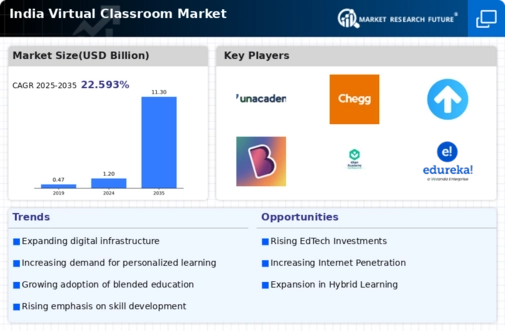Growing Emphasis on Skill Development
The virtual classroom market in India is increasingly focused on skill development, aligning educational offerings with industry demands. As the job market evolves, there is a pressing need for upskilling and reskilling, which virtual classrooms can effectively address. Approximately 80% of employers indicate a preference for candidates with practical skills, making virtual learning platforms essential for bridging the skills gap. This emphasis on skill development is likely to drive the growth of the virtual classroom market, as educational institutions adapt their curricula to meet the needs of the workforce.
Rising Popularity of Lifelong Learning
The concept of lifelong learning is gaining traction in India, significantly impacting the virtual classroom market. As individuals seek to enhance their knowledge and skills throughout their lives, virtual classrooms offer a convenient and accessible solution. Recent surveys indicate that nearly 65% of adults are interested in pursuing further education through online platforms. This trend reflects a cultural shift towards continuous learning, which is likely to sustain the growth of the virtual classroom market. As more people engage in lifelong learning, the demand for diverse and flexible virtual education options will continue to rise.
Technological Advancements in Education
Technological advancements are playing a pivotal role in shaping the virtual classroom market in India. Innovations such as artificial intelligence, augmented reality, and interactive platforms are enhancing the learning experience. These technologies facilitate real-time feedback and personalized learning paths, which are increasingly sought after by educators and students alike. The market is projected to grow at a CAGR of 20% over the next five years, driven by these advancements. As educational institutions adopt these technologies, the virtual classroom market is expected to witness substantial growth, reflecting the evolving needs of learners in India.
Rising Demand for Flexible Learning Solutions
The virtual classroom market in India is experiencing a notable surge in demand for flexible learning solutions. This trend is driven by the increasing need for personalized education that accommodates diverse learning styles and schedules. As students and educators seek more adaptable options, the virtual classroom market is poised to expand significantly. Recent data indicates that approximately 70% of students prefer online learning due to its convenience and accessibility. This shift towards flexibility is likely to reshape educational paradigms, making the virtual classroom market a critical component of the overall education landscape in India.
Increased Investment in Digital Infrastructure
Investment in digital infrastructure is a key driver of the virtual classroom market in India. The government and private sectors are allocating substantial resources to enhance internet connectivity and access to digital tools. Reports suggest that over 60% of educational institutions are upgrading their technological capabilities to support online learning. This investment is crucial for ensuring that students in remote areas can access quality education through virtual classrooms. As infrastructure improves, the virtual classroom market is likely to expand, providing more opportunities for learners across the country.

















Leave a Comment